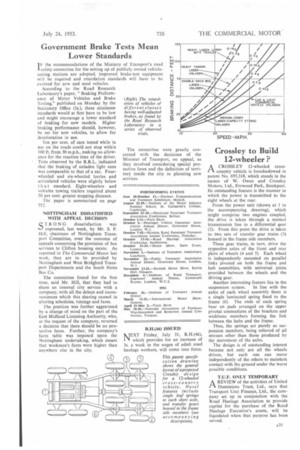Government Brake Tests Mean Lower Standards
Page 33

If you've noticed an error in this article please click here to report it so we can fix it.
IF the recommendations of the Ministry of Transport's road I safety committee for the setting up of publicly owned vehicletesting stations are adopted, improved brake-test equipment will be required and retardation standards will have to be evolved for new and used vehicles.
According to the Road Research Laboratory's paper, "Braking Performance of Motor Vehicles and Brake Testing," published on Monday by the Stationery Office (2s.), these minimum standards would at first have to be low and might encourage' a lower standard of braking for new models. Higher braking performance should, however, he set for new vehicles, to allow for deterioration in use.
Ten per cent, of cars tested while in use on the roads could not stop within 100 ft. from 30 m.p.h., making no allowance for the reaction time of the driver. Tests observed by the RILL. indicated that the braking of unladen light vans was comparable to that of a car. Fourwheeled and six-wheeled lorries and articulated vehicles were slightly below that standard. Eight-wheelers and vehicles towing trailers required about 50 per cent, greater stopping distance.
The paper is summarized on page 752.
NOTTINGHAM DISSATISFIED WITH APPEAL DECISION
QTR ONG dissatisfaction was I..) expressed, last week, by Mr. S. P. Hill, chairman of Nottingham Transport Committee, over the outcome of appeals concerning the provision of bus services to Clifton housing estate. As reported in The Commercial Motor last week, they are to be provided by Nottingham and West Bridgford Transport Departments and the South Notts Bus Co.
The committee found for the first time, said Mr. Hill, that they had to share an internal city service with a company, with all the delays and inconveniences which this sharing caused in altering schedules, timings and fares.
The position was further aggravated by a change of mind on the part of the East Midland Licensing Authority, who, at the request of the company, reversed a decision that there should be no protective fares. Further, the company's fares table was imposed upon the Nottingham undertaking, which meant that workmen's fares were higher than anywhere else in the city. The committee were greatly concerned with the decisions of the Minister of Transport, on appeal, as they involved considering special protective fares and the definition of territory inside the city in planning new services.
R.H.(46) ISSUED
KTEXT Friday, July 31, R.H.(46), which provides for an increase of 3s. a week in the wages of adult road haulage workers, will come into force.
This patent specifica lion drawing shows the general layout of a proposed Crossley design for a 12-wheeled Cross-COUntry vehicle. Novel features include single lee springs to each short axle, and transfer gears housed in the frame side members (see accompanying description),
Crossley to Build 12-wheeler ?
ACROSSLEY 12-wheeled crosscountry vehicle is foreshadowed in patent No. 693,318, which stands in the names of W. Owen and Crossley Motors, Ltd., Errwood Park, Stockport. Its outstanding feature is the manner in which the power is transmitted to the eight wheels at the rear.
From the power unit (shown at 1 in the accompanying drawing), which might comprise two engines coupled, the drive is taken through a normal transmission line to a differential gear (2). From this point the drive is taken . to two sets of transfer gear trains (3) housed in the frame side members.
• These gear trains, in turn, drive the respective axles of the front and rear pairs of wheels (4 and 5). Each wheel is independently mounted on parallel links pivoted on both the frame and hub assemblies, with universal joints provided between the wheels and the driving gear.
Another interesting feature lies in the suspension system. In line with the axles of each wheel assembly there is a single laminated spring fixed to the frame (6). The ends of each spring bear on pads arranged on the upper pivotal connections of the brackets and wishbone members forming the link between the hubs and the frame.
Thus, the springs act purely as suspension members, being relieved of all stresses other than those produced by the movement of the axles.
The design is of outstanding interest because not only are all the wheels driven, but each one can move independently of the others to maintain contact with the ground under the worst possible conditions.
T.U.F. ONLY TEMPORARY A REVIEW of the activities of United 1-1Dominions Trust, Ltd., says that Transport Unit Finance, Ltd., the company set up in conjunction with the Road Haulage Association to provide capital for the purchase of the Road Haulage Executive's assets, will be liquidated when that purpose has been served.




























































































